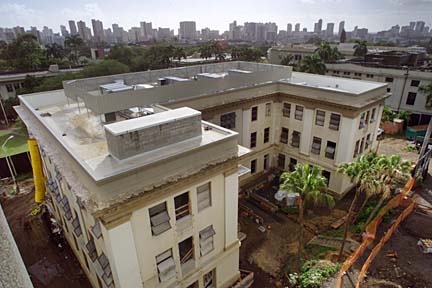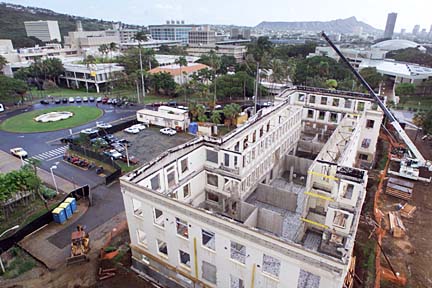


|
UH seeks to forestall The University of Hawaii underwent extensive construction from the 1960s to early '70s as more than a dozen buildings cropped up on the Manoa campus, but taxpayers wound up paying more than $1 million in repair work in the decade that followed.
costly building flaws
The university banks on autonomy
to take the reins of its
massive expansion plansBy Treena Shapiro
tshapiro@starbulletin.comFor example, the $4.4 million College of Business Administration building began crumbling in 1976, five years after it was built. One of its $400,000 towers eventually was demolished at a cost of $200,000 after it was discovered that clay under the building caused it to shift, leading to cracks in the walls and foundation as the building rose by as much as eight inches.
Now the university has announced 17 new construction projects across its 10 campuses, estimated at $52 million, and the UH administration wants to avoid the costly mistakes of the past with accountability and a standard operating procedure.
In the past, the state Department of Accounting and General Services handled the university's construction projects, but now UH will take charge of its own capital improvement projects because of autonomy, said Jack Bradshaw, a Massachusetts-based consultant contracted to do an analysis of the university's projects for UH President Evan Dobelle.
One priority will be determining how the university's constitutional autonomy relates to capital improvements.
"Autonomy, so far, has not been applied, or at least not to the extent that you can take a plan off the shelf and say this is how you do an x, y or z," said Bradshaw, who was hired under a three-year, $9,000-a-month contract. "The onus is now on the university to have full participation in the process."
Over the past few weeks, Bradshaw has interviewed more than two dozen people about UH construction projects and will be putting together a report this week.
Bradshaw has had ties to Dobelle for 33 years, working with Dobelle at two previous posts in New England. Bradshaw helped Dobelle to build two campuses at Middlesex Community College in Massachusetts and the Learning Corridor at Trinity College in Hartford, Conn.
This is the third time the two men have been in what Bradshaw calls the "emergency room." Each time, "the patient had several maladies. President Dobelle pulled it together," he said.
UH has a lot of opportunity, Bradshaw said. "Things are really beginning to shape up."
Still, the university's capital improvement difficulties have continued into the recent past.
Since taking office in July, Dobelle has seen the renovations of his house reach $1 million, more than twice the early estimates, and costs for an expedited paint job on Bilger Hall climbed to $700,000.
Dobelle, who recently announced his appointment of Allan Ah San to oversee a nearly $250 million construction program, said he is aware of the problems that the university has had with its buildings.

|
"Time, efforts and taxpayer dollars are not being expended wisely," Dobelle said.He told the faculty senate last month that as his senior consultant, Bradshaw would be looking closely over Ah San's shoulder.
Ah San, who has been with the university for 30 years, most recently as associate vice president for academics, declined comment on his new post.
More than $17 million in renovations to the gutted Hawaii and Crawford halls are ongoing.
Meanwhile, professors are still waiting to use the entire Pacific Ocean Science and Technology Center, which was dedicated in 1997, nine years behind the original schedule, $15 million over the original $37 million budget, with unusable laboratories and three floors left incomplete.
Former state comptroller Wayne Kimura said it will cost $12,742 to finish the building by early next year.
"We don't want this project to go on any longer than it needs to," he said.
C. Barry Raleigh, dean of the School of Ocean and Earth Science and Technology, said, "I'm delighted that it's going to be filled. It's really a fine building, with a few problems remaining. It's going to serve people well."
But the remaining problems include the "clean" isotope laboratory crucial to geochemist John Mahoney's research.
"We're using our old laboratory," in the Hawaii Institute of Geophysics and Planetology building, Mahoney said. "It's on its last legs. It's just about unusable now."
The new laboratory has had to be reconstructed twice because contractors have not met the exacting specifications for the lab, Mahoney said.
"The big problem was the air handling system, and I think they have that right now," he said. "We're dealing with very, very tiny samples that we're trying to analyze. One sniff of contamination basically destroys the experiments."

|
Problems now include the countertops, floors and epoxy coating on the walls. "We don't know when it's going to be done," Mahoney said.The problems in the POST building follow a familiar trend. Its neighbor, Holmes Hall, was finished in 1973 with an inflated price tag and insufficient facilities. As with POST, funding on Holmes ran out before the building was completed, but in that case, the second phase was never built.
And Holmes was one of many new buildings to see problems in the 1970s:
>> The aluminum fins that once adorned the sides of Kuykendall Hall had to be removed eight years after the building was finished, when the 60-pound decorative sunshades began to corrode and fall from the building.
>> The Biomedical Sciences Building, which will be renovated once the John A. Burns School of Medicine moves to Kakaako, had air-conditioning problems leading to fungus and vibration in the building.
>> Moore Hall also had faulty air conditioning, and ceilings had to be replaced shortly after they were put in because they caused acoustical problems.
>> In 1991, the American Bar Association's evaluation of the 8-year-old William S. Richardson School of Law included facility standard violations for mold and mildew in the library, inadequate maintenance and shoddy construction. The stench from the mold, also noticeable in the classrooms, was said to present a possible health risk.
But law school officials said the new facilities were an improvement over the cottages in the lower campus quarry that formerly housed law professors. In 1979, one cottage had to be demolished when the ground beneath it caved in, causing the floor of the building to sag into a newly created sinkhole.
>> Roof and window repairs to the $8.2 million Hale Aloha dormitories ran $460,000.
>> UH's Hale Noelani Apartments, completed for $6.31 million, required an additional $20,000 to stiffen springy floors.
>> Some $12.8 million was spent on the second phase of Kauai Community College, only to find that another $110,000 was required to repair leaky building walls and damaged interiors.
>> In 1981, hairline cracks were discovered in the exterior walls of the then-new gymnasium building, but these cracks did not cause structural stress or leaks.
>> Similar cracks were found in the new Art Building and Campus Center, as well, and windows in the Social Sciences Building cracked under pressure as the building settled.
The University of Hawaii announced recently that over the next 14 months, $52.165 million would be spent on construction projects, including planning, design and land acquisition. Planned construction projects for the University of Hawaii
Pending allotment
>> Manoa, Health, Physical Education and Recreation building addition ($900,000)
>> Manoa, makai athletic training room renovation and expansion ($650,000)
>> Hilo, Sciences and Technology Building ($1 million)
>> UH-West Oahu, campus development ($8 million)
>> Honolulu Community College, high technology programs ($3.689 million)
>> Honolulu Community College: Pacific Aerospace Training Center ($446,000)
>> Leeward Community College, food services program ($366,000)
>> Systemwide infrastructure improvements ($4.736 million)Recently allotted
>> Manoa, School of Medicine and Cancer Research Center ($13 million)
>> Hilo, multipurpose complex ($200,000)
>> Maui Community College, Food Services Program ($2 million)
>> Systemwide infrastructure improvements ($436,000)
>> Systemwide facilities improvements -- repair and maintenance ($10 million)Recently delegated
>> Manoa, Waikiki Aquarium sea wall and walkway ($983,000)
>> Systemwide modifications for accessibility ($1.068 million)
>> Systemwide health, safety and code requirements ($3.944 million)
>> Systemwide fire safety improvements, statewide ($747,000)
Ka Leo O Hawaii
University of Hawaii